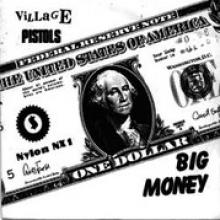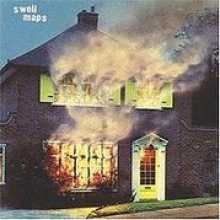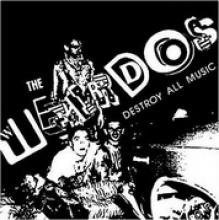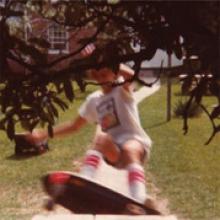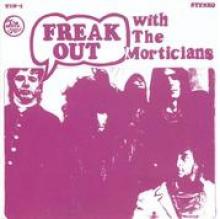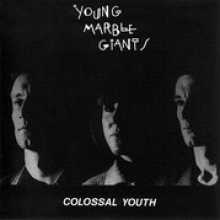The Village Pistols: A NC (Punk) Goof
The Village Pistols are not in anyway affiliated with the British punk scene. Its name would, obviously, lead listeners to figure otherwise. But if one got the chance to hear a few cuts from the band’s singles or any of its compilation appearances, the Village Pistols might still come off as the immediate precursor to Chaos UK and that strain of latter day punk.
Most of that association is by dint of the band’s vocalist grunting his way through whatever offering one lands upon. It’s not quite as disposable as the Exploited or that early crusty stuff, but gets pretty close.
Compounding that problem is the fact that the band didn’t ever work up a proper long player and only issued the lone Big Money seven inch. The b-side of that album, though, conflagrated confusion about where the band was from. It was a warp speed rendition of the Beatles’ “Strawberry Fields Forever.”
As ridiculous as this all sounds already, the Village Pistols formed as a goof on the Greensborough, North Carolina punk scene. Band members were of the opinion that there was an influx of new folks around that were just that – around, as opposed to contributing to any sort of positive vibe.
So, donning masks to obscure their identities, the Village Pistols took the stage, armed with a variety of covers, a few originals and (surprisingly) enough musicianship to get ‘em over. Never planning to make a real stink about it – and maintaining relative anonymity – the Village Pistols eventually just fell apart with its members drifting apart, becoming recluses or whatever other fates await those who adamantly loved punk with more than emotions.
Somehow, though, there were a few live performances captured during the band’s existence. One of those comprises the majority of Big Money, the album, not the single. It’s all a confusion seeing as the single is included at the head of compilation.
Over the course of the albums’ thirteen tracks, there’s actually a wide range of punk styles portrayed after that ridiculous single gets a run through. Subsequently, the recording reports on a band not necessarily adept at succinct time changes – “I’m not the Pop” – but probably more so then its contemporaries.
There’s no accounting for the entirety of Killed By Death #7 being named after this band’s only single. And while there’s better material in the Village Pistols bag, it’s not strong enough to warrant further inclusion on compilations.
Swell Maps Want to Know if You Believe in Art
If one were to toss on any of the more straightforward tracks from either proper Swell Maps’ full length – A Trip to Marineville (1979) and Jane From Occupied Europe (1980) – it’d be difficult for the uninitiated to differentiate between what was being heard and the Adverts or some other first wave punk ensemble from the UK.
That could be taken as a compliment or a detraction as the punk scene, especially towards the end of its first wave, turned into a spate of nonsensical reworkings of the most simplistic musics. But Swell Maps were only a tangential figure in all of that. The band’s strict adherence to DIY ethics was a part of the connection with the punk scene. Of course, the fastest and most distorted efforts from A Trip to Marineville easily qualify the Maps as skewed punkers. But of the course of that disc and its follow up, there’d be an ever expanding palette serving to distance the group from its initial punk cohort.
Even by Marineville’s fifth track “Harmony In Your Bathroom” it became clear that supplemental sound effects – here bubbling water of some variety – was as important to the band’s conception of music as anything else. The pummeling piano chord, supplied by drummer Epic Soundtracks, moves the band towards droney, kraut territory or even back the Velvet Underground’s heyday.
In the eyes of a great many critics, though, the band and its experimental streak was relegated to anonymity because of these explorations. Opening its second album, Jane From Occupied Europe, with “Robot Factory” and its accompanying industrial noise didn’t do too much to push the Maps towards commercial viability. Krautrock’s influence has been endlessly overstated in the band’s sound. But on this first track, it really does get pushed to the fore. With repetitive rhythms, minimal melodic ideas and that noisome background, Swell Maps reaffirmed it’s stance as a group of players concerned only with exploring personal limits and possibilities in its own music. And before too long – even if the band’s second disc was a solid and well conceived if not broader in its inclusion of non-musical elements – Swell Maps called it a day.
Releasing a few singles prior to its proper album’s and those long players themselves, though, cemented Swell Maps’ importance off into the future. Each band member went on to perform in other settings – Epic Soundtracks, his brother Nikki Sudden and bassist Jowe Head, who’d join the Television Personalities remain the best known. But everything even remotely affiliated with this crew possesses at least a bit of intrigue.
Dead Moon: A Proto-Grunge Manifesto
Dead Moon was and remains of the better regarded underground groups in American history to have any sort of passing flirtation with punk. Of course, the fact that Fred Cole has been working in one band or another since the mid sixties has more than a bit to do with Dead Moon’s musical faculties. But the guitarist and songwriter’s ability to reign in influence spanning the whole of his career is more than a good reason to figure Dead Moon’s music as the forbearer of what would eventually be termed grunge by the media masses.
There were obviously Seattle bands gigging around town – the U-Men, the Melvins and Green River – that were instrumental in the promulgation of what would become the Seattle sound. But Cole and his Portland based ensemble were around for the same years, were more adept at deft song craft. And while Dead Moon’s wide palette never included any semblance of a metal influence, the entire outsider aesthetic the band worked with was more than a bit obvious in Seattle’s music scene during the nineties.
Part of what made Dead Moon such an appealing ensemble, apart from the fact that Cole along with his wife were a bit older than the nascent scene just north of their home, was the huge amount of work the band issued.
Beginning as just a slew of singles, the group eventually landed a deal with some German imprint. And after issuing its own work for a while, Dead Moon was able to find a huge following in Europe.
Compiling some of those stray recordings on the 1990 Thirteen of My Hook, the band attempted to chart not just its development, but its influences. Moving from “War Baby,” to “I’m Out Nine” and finally into “Street of Despair,” listeners are going to be able to identify the first song as punk, the following track as a revved up rock ballad and that final effort as supped up rockabilly run through late seventies rock and roll.
It’s on “I’m Out Nine,” though that Cole and company most deftly display its talent. Without hiding behind screaming guitars and quick tempos, the band turns in a melodically satisfying and lyrically enticing track that should sate rock dudes and their sensitive girlfriends.
And that’s really what Seattle’s music scene sounded like. There was always that loud-soft dynamic, but Dead Moon and its adherents were able to insert more than a passing sense of heart into it all.
From Haino to People: More Japrock (Part One)
From the earliest appropriations of Western psych up through what amounts to the current day and making a stop at the boarder of the Fluxus movement, Japanese rock group’s have traversed difficult territory where any mode of psychedelia meets free improvisation. Like any number of Western group’s, these J-Rock adherents occasionally miss the mark completely and fall into a self indulgent, and self congratulatory mess that only few people can fool themselves into listening to.
Noticeably absent from this round up as well as an early exploration of this music, focusing perhaps on older and even more obscure groups, is Acid Mother’s Temple as fronted by Kawabata Makoto. But that’s only because the band’s kinda boring and apes the style these other group’s settled upon prior to ACT being formed. Either way, hopefully, these few acts serve as proper entrance to a music that’s as wide reaching as it is endless difficult to fully comprehend. And there will be no references to Zen…anywhere.
This group is probably one of the less renowned ensembles coming out of the J-rock tradition. It’s album cover makes it seem as if what’s inside might be a take on Eastern classical forms. It’s not, though. Instead, there’s as much heavy instrumental psych as anything else on the list here. Instead of the band pummeling listeners, though, People take the time to ease into the tripped out explorations which comprise the group’s only long playing recording.
There’s a mythical aura about this group. At one time band members were even rumored to be in talks with the Velvet Underground’s Moe Tucker about performing together. That would have been a good match. It didn’t happen, unfortunately. But what LRD was able to do on its own – and mostly in live recording scenarios – is take some ripped of, revved up R&B concept, turn it upside down and slather it in feedback. Good stuff, if a bit repetitive and long winded.
Kinda overrated as far as I’m concerned. While the band’s album covers might make it seem that there’s nothing other than spaced out rock stuff, a great deal of this is just dressed up prog. It’s wondrous, though, that a band simply due to its associations with this weird sub-sub-genre could garner an international following decades after releasing work. That again goes to show that folks are sheep. Good segue.
TWOFR: The Weirdos x Wavves
The Weirdos
Destroy All Music
(Bomp!, 2008)
It’s a curious thing. As collectors of punk ephemera age, maintain jobs that can support frivolous habits and continue to stock pile any remotely relevant snotty nugget, this community of nerds, grown ups and label heads seem to ever more resemble jazz collectors. Surely, there’s some overlap, but even in the releases being offered up, one notices similarities to track sequencing and packaging. For instance, would the listener prefer to hear the two existing studio versions of “Destroy All Music” back to back? To a certain extent, it doesn’t matter, because this release will be purchased by those that hoard music. These songs are all of a variety of punk that has been disseminated in the past thirty years. However, the Weirdos helped create what would become trite and clichéd. There are demos, most of which would eventually become the Destroy All Music disc and the single itself. Rounding the compilation out is the Who? What? When? Where? Why? mini-album, which seems to have more in common with ‘80s hard rock than punk. Curiously, the Dangerhouse single We Got the Neutron Bomb is absent. With that glaring omission collectors, geeks and completists will unquestioningly keep the Weird World compilations within arms reach.
Wavves
Wavvves
(De Stijl, 2009)
We’re about a week deep into the new year and this disc is and will continue to be the most checked, revered and discussed album. Whether it’ll matter in 2010 is another issue all together.
The dude that is Wavves seems to be consistent amidst his punkier compositions. The slow numbers, “Jetplane (Staying on a)” perhaps, finds the limited vocal and melodic palette accentuated by the space left in the track. Wavves is not a crooner and that’s why “No Hope Kids” ends up working out a bit better. But even here, the frailty of Wavves’ musicality is apparent.
Following that song is one of the numerous sound collage/avant-noise pieces that, if used sparingly, could prove an ingenious way to connect songs. Instead, it just allows listeners to figure out that the dude that is Wavves likes to get high – but we shouldn’t blame him.
At around thirty minutes, there seems to be a lot of wasted time. And Wavvves would really have been an incredible mini-LP or series of singles, but as a whole, the tracks aren’t assembled in a way that warrants all the hype. His writing covering the sun, goths and skating/surfing obviously comes from a goofy personal place and that’s why those seem to stand out.
But considering that in the last few months Wavves has put out this disc, a tape, another full length and a single if and when he figures out how to harness the thing inside him that drives his art, I’ll be listening.
Come On and Freak Out in the Morticians' Garage
Amongst the refuse pile that was the eighties’ psych and garage revival were a handful of notable releases. Of course, anything dug up at this point will unquestionably be lauded as the missing link between those olden days and newer tripped out sounds. The Morticians have probably had all that levied upon it – warranted or not. And while there’s not a good reason to dismiss the band, there’re actually a couple reasons that the group’s 1987 Freak Out with the Morticians should be explored a bit.
Firstly, the album’s cover is an obvious homage to Frank Zappa and the Mothers’ of Invention’s first album. The title’s even basically the same save for band names being swapped in and out. There isn’t anything here making the band as political or social as interesting as Zappa’s troupe, but that can’t be expected from every ensemble.
In keeping with the throw back phenomenon, the Morticians even see fit to include a version of The Litter’s "Action Woman." It’s not a tremendous shock – the song counts as the Litter’s only worthwhile effort – but again works to cement this group’s dedication to dead sounds.
Part of the backwards gaze at psych stuff, the original LP version of Freak Out with the Morticians was split into two distinct sides, each concerning itself with either punk or psych. It’s either a well telegraphed play at appealing to two disparate markets or it’s just a goof. In hearing that first side that’s supposed to be punk related, there’s surely a nasty garage thing going on, but by 1987 there were countless definitions of punk ranging from what’s here to the Exploited and back again.
Of more interest, since that first side’s all short takes on the garage form, is the second half of the album – that pysch stuff. And while there’s no new ground broken here, natch, some of the Morticians’ productions are capacious of surprising listeners.
During “Spiral Bat,” which begins with cribbed Bo Diddley lyrics, the group gets all improvisational on listeners. And while that might not sound too engaging, there’re are enough odd sounds, assumed added in post production, that folks hearing the album might find it necessary to turn the volume down for a moment just to see if the aural theatrics are from the recording or some street hassle outside.
None of this is required listening for the psych and garage traveler, but it is a surprising high point for the mid to late eighties underground music scene.
Woodsman - "Balance" (Video)
Young Marble Giants: Cardiff After Punk Washed off into the Mouth of Seven
In reading about the now mythic Young Marble Giants, a Brit band put together at the tail end of the seventies as punk stopped being anything near useful, it’s amusing to see time and again the ensemble referred to as either poppy or progenitors of post-punk.
That first concept – the band being poppy – is most likely derived from the fact that YMG’s singer, Alison Statton, possessed a high pitched, pleasant voiced which would have been well suited for sixties’ styled bubblegum work outs. Oddly contrasted with the sparseness of the band’s music, Statton, whose voice is placed high in the mix, floats above what could be understood as minimal music.
Using just a guitar, bass, synth and tape loops of drum patters on occasion, YMGs weren’t engaged in the pursuit of pure pop synthesis. Synthetic, yes, but the band’s orientation in relationship to popular sounds is one removed from the norm. While more readily digestible than most punk stuff floating around at the end of its first wave, YMG still weren’t anywhere near the new wave stuff, some of which surprisingly made us of similar instrumentation.
Figuring the band as post-punk presents a wealth of troubles. Firstly, the genre itself doesn’t have a definitive sound and is seemingly based on the concept of time – if you’re band cropped up after 1977, there’s a good chance that someone’s referred to ya’ll as post-punk. The signifier, though, when understood in context most frequently means group’s like Wire, the Mekons or Gang of Four, none of which share commonalities with YMG. If there was to be an obtuse relation made, it might be that each of those post-punk group’s made use of rhythm sections indebted to Jamaican music. YMG, on occasion, could have been said to use the same concepts to sure up it’s bottom end, which most frequently didn’t count any sort of percussion, inauthentic or not.
Whatever the band was, it was able to craft some enduring music – Nirvana, Hole and the entire Northwest cohort were fans. Tracks like “The Man Amplifier,” twee as all get out, might seem to be too fey for those gnarly northerners to embrace. But the simplicity inherent in YMG’s music was easily transferable to unadorned rock and roll music as it was recast during the late eighties and early nineties.
With YMG’s catalog being reissued a few years back, there was a surge in interest. But with band members taking care of normal life stuff, recording and extensive touring don’t look to be on the horizon.
Tales of Terror: A Secret History of Sacto Punk
There are probably more bands hailing from Sacramento than most folks would be able to name. Despite the city’s relative proximity to the Bay Area, group’s don’t very frequently make it to a great renown. Ganglians was the town’s last shot, but it doesn’t appear that the ensemble is going to turn in work as well wrought as “In June.” Bummer.
Either way, twenty some odd years prior to Ganglians releasing small run records through Woodsist, Tales of Terror showed up, presented a promising future and then subsequently fell apart. It’s pretty much the same story as any number of other punk bands hailing from the early and mid eighties with one difference. A lot of people figure the band as the impetus for the Seattle thing that would crop up a few years after the band’s dissolution.
That break up, though, wasn’t predicated on in fighting or some other nonsense. Instead, all it came down to was Lyon Wong inheriting the ire of some town’s folk, getting punched in the head and his head thusly smacking concrete. He died before making it to the hospital. Tales of Terror decided to pack it in with a few members going on to play with some other local groups.
What it left behind in the form of a single long playing record, though, is enough to solidify the band’s legacy. Issued in 1984 the self titled album has been used to make a case for ToT’s influence on the nascent Seattle scene. Green River was an avowed fan covering the Sacto band’s “Ozzy.” Kurt Cobain too included some of ToT’s work in various ‘best of’ lists found in his diaries. Of course, the U-Men were kicking around the Northwest before ToT issued work, but that seems to have been forgotten for convenience’s sake.
ToT’s wide range of influences are used as much to make that case. Surely, there’s some hardcore in the Sacto band’s sound as evidenced on “Deathryder,” which cops a slightly augmented Black Flag guitar sound. The hard rock run through Germs’ territory of “Chambers of Horror” lends credence to the band’s all inclusive approach as does the mutant rockabilly during “Over Elvis Worship.”
Like most instances of conjecture, there’s no way to sure any of this up. Certainly hearing some of ToT’s singer loosing his nut works in this equation. But there were countless groups working in this mode. ToT might not have changed anything about Seattle, but their recorded work remains impressive nonetheless.

